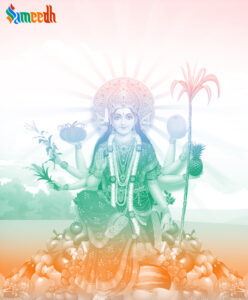Goddess Shakambhari is a form of the Divine Mother, particularly revered in Hinduism for her role as the provider of food and nourishment.

The name “Shakambhari” is derived from two Sanskrit words: “Shaka,” which means vegetables or greens, and “Ambhari,” which means one who bears or supports. Therefore, Shakambhari is often depicted as the goddess who nourishes all beings with her abundant supply of fruits, vegetables, and grains.
Goddess Shakambhari is considered an incarnation or aspect of Goddess Parvati, the divine consort of Lord Shiv in Hindu mythology. Parvati is one of the principal goddesses in Hinduism, representing various aspects of femininity, strength, and nurturing qualities.
Shakambhari is specifically associated with Parvati’s aspect as the nurturing mother who provides sustenance and nourishment to all beings. The name “Shakambhari” is derived from Sanskrit words meaning “vegetables” or “greens” (Shaka) and “one who bears or supports” (Ambhari). As Shakambhari, Parvati embodies the abundance of nature and is worshipped for her role in providing food, fertility, and sustenance to the world during times of scarcity and famine. Therefore, while Shakambhari is revered as a distinct form of the Divine Mother, she is ultimately considered a manifestation of Goddess Parvati’s compassionate and nurturing aspect.
Here are some key aspects of Goddess Shakambhari:
- Goddess of Nourishment: Shakambhari is worshipped as the embodiment of abundance, fertility, and sustenance. She is believed to manifest during times of drought, famine, or scarcity to provide food and nourishment to all living beings. Devotees invoke her blessings for agricultural prosperity, abundance of crops, and alleviation of hunger.
- Iconography: Goddess Shakambhari is often depicted as a benevolent deity adorned with various fruits, vegetables, and grains, symbolizing her association with food and sustenance. She is depicted with multiple arms, each holding different types of vegetation. Her compassionate expression reflects her role as the provider of nourishment and sustenance.
- Mythological Significance: According to Hindu mythology, Goddess Shakambhari manifested during a severe famine to alleviate the suffering of all beings by providing an abundance of food and nourishment. Her divine intervention is seen as a demonstration of the Mother’s compassion and care for her children.
- Festivals and Worship: Shakambhari is worshipped with devotion and reverence, particularly during the month of Pausha, and especially on the auspicious day of Pausha Purnima. Devotees offer prayers, perform puja (worship), and make special offerings of fruits, vegetables, grains, and sweets to seek her blessings for prosperity, well-being, and abundance.
- Spiritual Significance: Shakambhari’s worship is not only about physical nourishment but also about spiritual sustenance. Devotees believe that by invoking her blessings, they receive not only material abundance but also spiritual fulfillment and divine grace.
Overall, Goddess Shakambhari holds a significant place in Hindu mythology and is revered as the compassionate bestower of food and nourishment, symbolizing the divine mother’s boundless love and care for all living beings. Devotees worship her with gratitude and devotion, seeking her blessings for abundance, prosperity, and well-being.
